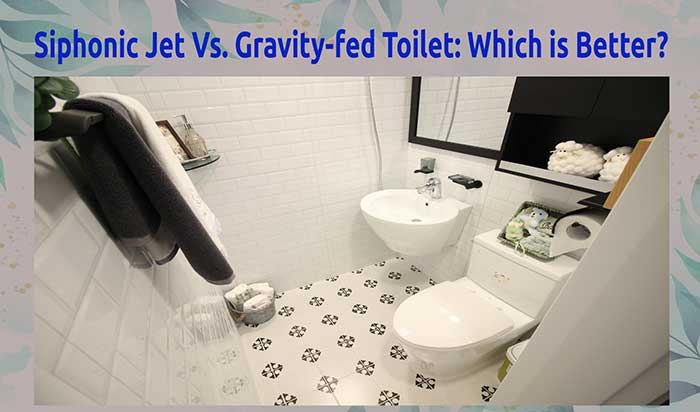One of the most important aspects of buying a toilet is the flushing capability. No one wants to flush twice or worse, deal with an improperly working toilet. Imagine the level of embarrassment you can face if your visitor uses the bathroom only to find it unclean. It’s not cool at all.
There are so many toilet flushing technologies to consider. A few powerful ones include pressure-assist, siphonic, and gravity-fed. Now, while supremely effective, pressure-assist can be disturbingly noisy to kids and the elderly. This leaves you with two choices-gravity-fed and siphonic. So the question is, which one is better?
Keep reading to find out.
Decoding Siphonic Jet Toilets
A siphonic jet toilet has an S-shaped (aka reverse P) trapway. When you press the flushing button, water is delivered at a faster rate than is exiting the bowl. This makes the water rise in the bowl creating a vacuum (siphon) that sucks all the waste out.
Siphon toilets are so effective in flushing and don’t leave streak marks behind. Once you are done, you can hear some gurgling noise which indicates the vacuum has passed.
Siphonic Jet Toilets Water Consumption
Previously, toilets would use as much as 5 gallons to flush. Courtesy of government regulations, now most manufacturers produce toilets that flush at a max rate of 1.6 gallons per flush (GPF). Even better, some siphon toilets can flush impressively with much less water.
Why a Siphonic Jet Toilet?
As we mentioned before, siphonic jet toilets are reliable at flushing. Of course, this can vary depending on the size of the bowl and trapway. The bigger the trapway, the better the flushing process. You will also appreciate the silent flush that doesn’t wake anyone during those midnight bathroom sessions.
Secondly, these toilets retain a significant amount of water in the bowl which helps to keep drain pipe smells away.
How Can You Tell if a Toilet Is Siphonic?
By the way, realize that you cannot see the S or P shape of siphonic toilets because it’s hidden in a skirted design. The only possible way to know is by looking at the water surface-it should be large. These toilets sport a water surface measuring 7 by 8 inches or more.
Cons of Siphonic Toilets
- The bends in the trapway can easily bring about clogs in case there too much waste to be flushed
- The size of the bowl might be bigger for some member of the family (especially kids)
Gravity-fed Toilet
As the name suggests, a gravity-fed toilet relies on gravitational force to push waste down the drain. Because of this mechanism (push downforce), it’s also sometimes called a washdown toilet.
How It Works
This toilet depends on the incoming water and the downward push to move waste. While others require too much force, this one doesn’t because the trapway is short and wide. This makes for a smooth ride of waste
Normally, gravity-fed toilets have double the size of the trapway as siphonic toilets. This explains why most of them don’t clog often. So yes, they are one of the most dependable no-clog toilets for commercial places and homes with many kids and adults.
Identifying a Gravity-fed Toilet
There are a few highlights that can guide you to picking out gravity-fed toilets. Unlike a siphonic model, they have a small water surface of approximately 4 by 5 inches.
They have wider (usually 4 inches) and shorter trapways that are hidden behind a skirted design. Many of these toilets sport flushing buttons rather than trip levers. Also, they have dual flushing systems that allow for both half and full flushing.
Why a Gravity-fed Toilet?
There are a few reasons why a gravity-fed toilet may be a worthwhile investment. First, you get a dual flushing option that not only saves water but money as well. Secondly, they clog less often thanks to their wider and shorter trapways. check out our piece on dual flushing toilets for reliable choices.
Lastly, gravity-fed toilets are quite affordable compared to siphonic jet models.
Cons of Gravity-fed Toilets
- The low water level in the bowl could easily invite drain smells back to the house or leave bowl stains
- At times they are noisy and that can be uncomfortable at night
- You may need to flush the toilet twice in case of large solid waste
Wrap up
So which is better between siphonic jet toilet and gravity-fed toilet? Well, to be clear, they are both among the best toilets with widespread adoption. As you have seen, each model has its own pros and cons.
If you want a toilet that runs quietly and has the least chances of letting in smells, you better go with a siphonic jet toilet. If you are hellbent on a bigger trapway and dual flushing systems, a gravity-fed toilet will appeal to you.
Don’t let analysis paralysis steal your time. Simply let your preferences guide you.
Related Resources:

